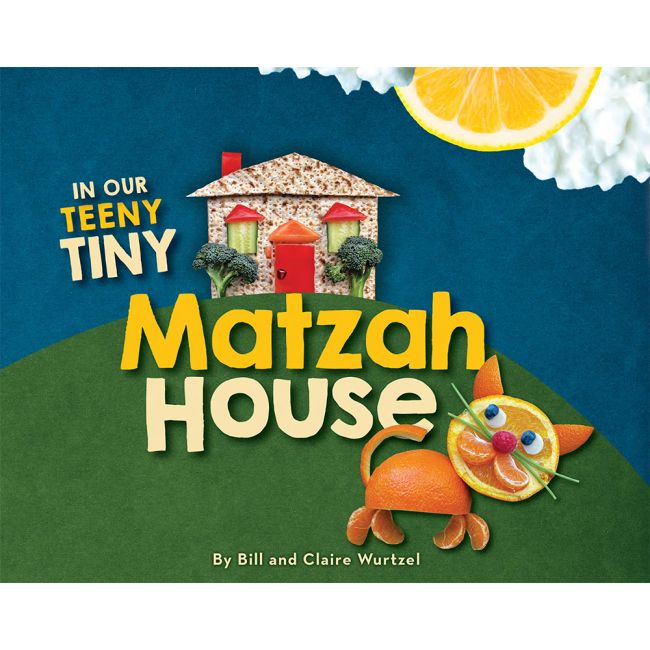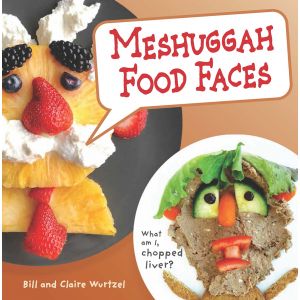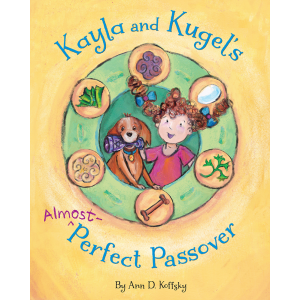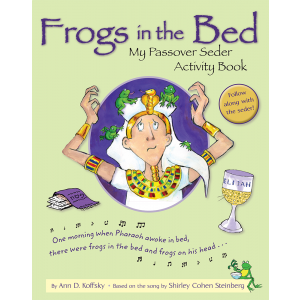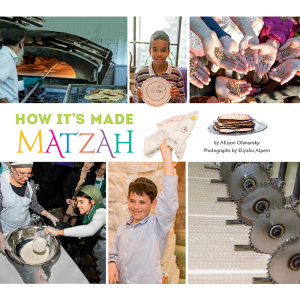In Our Teeny Tiny Matzah House
I live in a teeny tiny matzah house.
It is so crowded and noisy in here that I can't hear myself meow.
Where will we put all our guests for the Passover seder?
A cat made of oranges and its veggie family is wondering how they will be able to fit all the Passover guests into their teeny tiny matzah house for the seder.
The classic Jewish folktale of the too-crowded house has never been so delicious!
Includes step-by-step directions for making your own food art.
About the Authors
Bill Wurtzel is an artist and jazz musician, so improvisation, even with food, comes naturally to him. He began making food art to amuzse his wife, Claire, when they were first married and has never stopped.
Claire Wurtzel is the co-educational director of Hidden Sparks. She has loved food art ever since she was a child, when her mother would shape challah dough into little birds or funny objects.
Bill and Claire collaborated on Meshuggah Food Faces and other books of food art. They live in New York City.
Reviews
Creatively imagined and artistically rendered, this picture book tells the simple story of a family of whole, sliced, and segmented fruits and vegetables who lives in a very small house constructed of matzah.
Kitzel the cat, who narrates the story, is made entirely out of an orange. His head and body are each half an orange, while his mouth and feet are orange segments. The mother is a veritable salad of parts: her head is an onion with onion-skin hair; her mouth and body are vivid red peppers; and her arms and legs are carrots. Two pieces of parsley serve as eyelashes and eyebrows. Other family members are similarly tasty and amusingly named: Avo, the avocado brother; Celeria, the stalky sister who is flexible enough for gymnastics; and a whole pantry full of innovative, crunchy others.
It is almost Pesach. After disinviting some chametz friends personified by a bagel, a piece of cake, a roll, a donut, and a challah, the family worries whether they will have enough space in their teeny tiny matzah house to conduct a seder. Family and friends arrive in a variety of edible conveyances, including a carrot airplane, a cheese helicopter, and a floating hot-air watermelon. Some friends join remotely via a computer screen framed in celery. The seder proceeds deliciously with traditional, joyful retellings, songs, and, of course, afikomen-hunting. As in the traditional Jewish folktale, retold in many versions, the previously crowded house feels spacious when the guests have departed.
The story is simple, but the art is ingenious. Directions for making a cat out of an orange are included — a fun, Passover-friendly project sure to engage parents and children who are looking for an unusual and innovative kitchen activity to work on together.
--Michal Malen, The Jewish Book Council
Told from the perspective of the house cat Kitzel, Bill and Claire Wurtzel’s In Our Teeny Tiny Matzah House is about a family who lives in a crowded teeny tiny matzah house and needs to prepare for Passover and the seder. The illustrations use photographs of ordinary foods (such as oranges, cottage cheese, celery, peppers, cantaloupe, avocado, strawberries, bananas, carrots and more) in extraordinary ways giving rise to expressions on the characters' faces that are simply remarkable. Favorites of this reviewer included the Statue of Liberty with broccoli torch, Souperman with a matzah ball nose, Mat Zahbrei, Cantor Loupe and Flankenella. Back matter includes step-by-step instructions to make Kitzel.
The story mentions many elements of Passover and the seder including ridding the house of bread (watch that donut with wafer hair walk away!), asking the Four Questions, listing the ten plagues, searching for the afikomen, singing Dayeinu, and of course, having guests to celebrate it all with, whether in person or remotely. But in addition to being a fun-to-read book, the magic of the storyline is brought out through the uniqueness of the food art illustrations. As such, readers may enjoy this book long after Passover has ended by trying to replicate the many characters within and coming up with their own original creations. Overall, an excellent addition to bookshelves for children of all ages and faiths that stimulates imagination, creativity and viewing art through an entirely different lens.
--Freidele Galya Soban Binaishvili, Sydney Taylor Schmooze
Creatively imagined and artistically rendered, this picture book tells the simple story of a family of whole, sliced, and segmented fruits and vegetables who lives in a very small house constructed of matzah.
Kitzel the cat, who narrates the story, is made entirely out of an orange. His head and body are each half an orange, while his mouth and feet are orange segments. The mother is a veritable salad of parts: her head is an onion with onion-skin hair; her mouth and body are vivid red peppers; and her arms and legs are carrots. Two pieces of parsley serve as eyelashes and eyebrows. Other family members are similarly tasty and amusingly named: Avo, the avocado brother; Celeria, the stalky sister who is flexible enough for gymnastics; and a whole pantry full of innovative, crunchy others.
It is almost Pesach. After disinviting some chametz friends personified by a bagel, a piece of cake, a roll, a donut, and a challah, the family worries whether they will have enough space in their teeny tiny matzah house to conduct a seder. Family and friends arrive in a variety of edible conveyances, including a carrot airplane, a cheese helicopter, and a floating hot-air watermelon. Some friends join remotely via a computer screen framed in celery. The seder proceeds deliciously with traditional, joyful retellings, songs, and, of course, afikomen-hunting. As in the traditional Jewish folktale, retold in many versions, the previously crowded house feels spacious when the guests have departed.
The story is simple, but the art is ingenious. Directions for making a cat out of an orange are included — a fun, Passover-friendly project sure to engage parents and children who are looking for an unusual and innovative kitchen activity to work on together.
--Michal Malen, The Jewish Book Council

